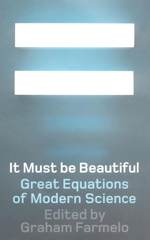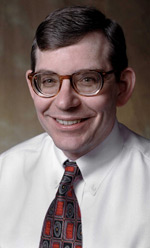Review of "It Must be Beautiful: Great Equations of Modern Science"

Author(s): Graham Farmelo, Editor
Published: February 2002, Granta Books, ISBN: 1862074798
 by David Ward, Ph.D., Professor of Physics
by David Ward, Ph.D., Professor of Physics
July 194, 2004 -
I was once a dedicated biology student, planning to leave high school for college and, hopefully, a career as a surgeon. But a wise guidance counselor put me in physics and there I discovered equations. I fondly recall using an equation to predict where a small marble would leave a table top and land on the floor. I placed a cup on the floor at the calculated spot, released my marble and plunk! Into the cup it went! I was hooked. Mathematics was useful! Equations were beautiful! Off I went to college anxious to major in physics. Over time I acquired a new goal of conveying the beauty of mathematical physics to students. I had come to realize that the equations of science were indeed beautiful.
So the title alone, It Must be Beautiful: Great Equations of Modern Science, was sufficient to require that I buy the book. How could I go wrong? I was not disappointed in my purchase.
This small volume contains eleven essays by experts in their fields covering topics in biology, chemistry, communications, physics, and even searching for extraterrestrials. Owing to my physics nature I was most blessed by the physics offerings, of which there are six. All of the essays cover equations developed during the era of “modern science”- that is, since the year 1900. A fine Forward by the editor, Graham Farmelo, a physicist at Northeastern University, begins the volume. The book concludes with a short Afterword by Steven Weinberg.
Perhaps the greatest value of the book for the general public is to find out that mathematics plays an important role in many fields. A good example is an essay on the Logistic Map entitled The Best Possible Time to be Alive, by Robert May, a Zoology professor at Oxford. Professor May is a theoretical biologist who first obtained a PhD in physics. He then migrated to biology when he became fascinated with applying mathematics to populations. The Logistic Map he discusses is an amazingly simple equation that fascinates mathematicians and biologists alike. Professor May explains this equation and goes on to illustrate its usefulness in biological communities. The essay is quite informative, lively and entertaining. Chaos Theory, Meteorology, and Biology are all addressed in this essay.
Communications Engineering is the focus in the essay Understanding Information Bit by Bit by Igor Aleksander, an Engineering Professor at Imperial College, London. This essay discusses the pioneering work of Claude Shannon in the late 1940’s. Shannon was the first to quantify information content with an equation. Shannon’s equation is discussed. I found portions of this essay to require re-reading, due in part to my poor familiarity with the bits and bytes of today’s digital world. Shannon’s work has led to a larger field called Information Theory, a branch of communications theory that has proven to be applicable even to statistical physics.
My greatest disappointment was the essay A Mirror in the Sky by Oliver Morton, a science writer for Wired magazine. The equation discussed is the Drake Equation, an equation that supposedly estimates the number of radio-emitting civilizations in our galaxy, N. Radio astronomer Frank Drake wrote the equation in 1961 for a scientific meeting. The equation contains products of fractions (actually, probabilities) that have to be guessed to yield N. The value of N is important in the ongoing Search for Extraterrestrial Intelligence (SETI) program, for if N is large radio telescopes could focus on smaller regions of the sky and have hope of “hearing” another civilization. If N is small, the better program would be to sweep the entire sky. Morton does a good job of discussing the fractions in the equation as well as the history of SETI, which is very interesting. But I don’t feel that the Drake Equation merits a place in the book. The equation is not particularly “beautiful” in that it makes no predictions, possesses no solutions, and has parameters that must be simply guessed. (By the way, Morton makes one small error, placing the Arecibo radio telescope in Costa Rica. It is actually located in Puerto Rico.)
Moving to Physics the most fascinating essays cover three of the most basic equations of modern physics: E=hf , E=mc2, and the Schroedinger Equation. E=mc2 is perhaps the most well-known equation of all time, and it is the equation that ushered in the atomic age. This is part of the beauty- a compact yet far-reaching relationship between physical variables. E=hf was the revolutionary equation for the energy of light quanta that ultimately resulted in the field known today as Quantum Mechanics. The essay covering the Schroedinger Equation (the foundational differential equation of Quantum Mechanics) has the most interesting history in the book, detailing the feuds between Schroedinger and Heisenberg. Along the way we learn of Schroedinger’s numerous infidelities and his disdain for formality in behavior and dress. We further learn that part of the Heisenberg-Schroedinger debate centered around aesthetics more than physics. These essays alone are worth the price of the book.
The reader certainly learns that beautiful equations are sometimes composed after tremendous labor and sometimes written down after a flash of insight. The equation composer sometimes insists on the properties of the equation based on aesthetic considerations. Also, as is made clear by Weinberg’s Afterword, all beautiful equations are approximations to physical reality. After all, theoretical science is an imperfect model-building process. That is, equations are a man-made approximation to a deeper reality.
We then wonder- is it even possible to ever construct an equation, or a set of them, that perfectly describes physical reality? Are all equations constructed or are some of them discovered? Just what is it that makes an equation beautiful, anyway? Why is it that mathematics even works at all in describing nature? I would have liked to see some of these questions discussed in depth, but they were barely touched on. (Certainly, some of the answers to these questions are related to the nature of God and man’s creation in His image.)
Nonetheless, the volume is a valuable addition to the library of anyone interested in science and mathematics. Whether you are math-phobic or a math geek, a trip through these pages should result in bringing mathematics more alive to you. You will learn that equations have a rich history and that they each possess their own unique individuality. You will find equations that may be appreciated just as much as a great painting, a precisely constructed sonnet, or an imposing cathedral. Perhaps you might even become intrigued enough to pursue a science or math degree!

